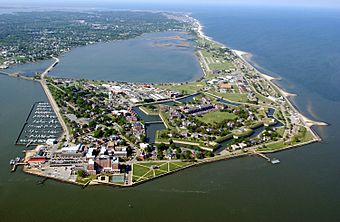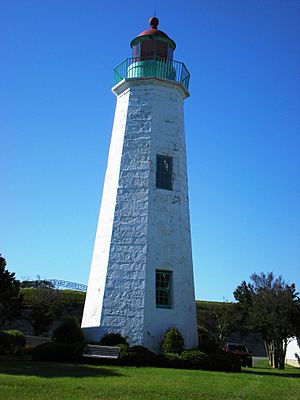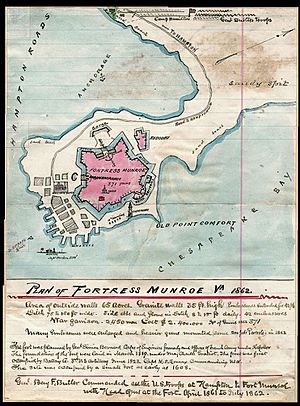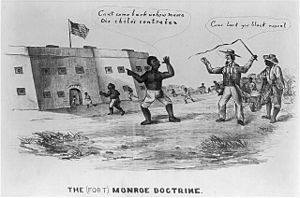Fort Monroe facts for kids
Quick facts for kids Fort Monroe |
|
|---|---|
| Part of Harbor Defenses of Chesapeake Bay 1896–1945 | |
| Type | Headquarters, garrison fort, training center |
| Site information | |
| Owner | Federal, State, Local |
| Open to the public |
Yes |
|
Fort Monroe National Monument
|
|

Fort Monroe in 2004
|
|
| Location | Hampton, Virginia |
| Area | 565 acres (229 ha) |
| Built | 1819–1834 |
| Architect | Simon Bernard |
| Architectural style | Third system fort |
| Website | Fort Monroe National Monument |
| NRHP reference No. | 66000912 (original) 13000708 (increase) |
| Significant dates | |
| Added to NRHP | October 15, 1966 |
| Boundary increase | March 9, 2015 |
| Designated NHLD | December 19, 1960 |
| Designated NMON | November 1, 2011 |
| Site history | |
| Built by | U.S. Army Corps of Engineers |
| In use | 1823–2011 |
| Materials | stone, brick, earth |
| Battles/wars | American Civil War World War I World War II |
Fort Monroe is a very old military base in Hampton, Virginia. It sits at Old Point Comfort, which is the southern tip of the Virginia Peninsula. Today, it's a special place called the Fort Monroe National Monument. It's looked after by the Fort Monroe Authority, the National Park Service, and the city of Hampton.
Fort Monroe and another fort called Fort Wool used to protect the important water passage. This passage connects the Chesapeake Bay to Hampton Roads, where several rivers meet. For many years, the fort protected the entire Chesapeake Bay and Potomac River areas. This included the water routes to cities like Washington, D.C., and Baltimore, Maryland. It also guarded important shipyards and naval bases in the Hampton Roads area.
Fort Monroe is surrounded by a moat (a deep, wide ditch filled with water). It has six sides and is the largest fort in the United States by area. People started building defenses here as early as 1609. The first fort was a wooden one called Fort Algernourne. The much bigger stone fort we know today as Fort Monroe was finished in 1834. It was named after U.S. President James Monroe.
Even though Virginia joined the Confederate States of America during the American Civil War (1861–1865), Fort Monroe stayed under the control of the Union army. It became known as "Freedom's Fortress" because enslaved people who reached it could find freedom. After the war, former Confederate President Jefferson Davis was held prisoner here for two years.
Over the years, Fort Monroe became a major military headquarters. It housed important artillery schools and training commands for the U.S. Army. The fort was officially closed on September 15, 2011. Many of its jobs moved to nearby Fort Eustis. On November 1, 2011, President Barack Obama made parts of Fort Monroe a national monument. This was done to protect its natural and historical importance.
Contents
Fort Monroe: A Historic Fortress
Fort Monroe covers 565 acres. It has 170 historic buildings and almost 200 acres of natural areas. This includes 8 miles of waterfront and 3.2 miles of beaches on the Chesapeake Bay. It also has a marina with 332 boat slips.
Early History of the Area
The land where Fort Monroe stands became part of Elizabeth Cittie in 1619. Later, it was part of Elizabeth City County. In 1952, this county joined with the city of Hampton.
First Settlements and Forts
In 1607, Captain John Smith and other colonists arrived and started the Jamestown settlement. They quickly saw that Old Point Comfort was a very important place for defense. They built Fort Algernourne there in 1609. It was a triangular wooden fort, similar to the one at Jamestown. This fort burned down in 1612. Other small forts were built nearby in 1610.
In August 1619, a Dutch ship arrived at Old Point Comfort. It carried more than 30 Africans who had been taken from a slave ship. These Africans were traded for supplies and became the first Africans to arrive on British land in what would become the United States. Their arrival is seen as the start of slavery in America.
Another fort was built in 1632, and then Fort George in 1728. A hurricane destroyed its stone walls in 1749. But its wooden buildings were still used until at least 1775. During the Siege of Yorktown in 1781, French forces used the ruins of Fort George.
Building the "Gibraltar of Chesapeake Bay"

After the War of 1812, the United States realized it needed better protection for Hampton Roads. In 1819, President James Monroe planned a network of coastal defenses. Construction of the large stone-and-brick fort began in 1822. This fort would protect the Chesapeake Bay. It became the largest stone fort ever built in the U.S.
One of the first buildings was Quarters 1, designed for the fort's commanding officer. The fort was designed by a French general named Simon Bernard. He had been exiled from France after Napoleon's defeat. The fort has a moat that completely surrounds its inner buildings.
A young engineer named Robert E. Lee worked at Fort Monroe from 1831 to 1834. He helped with the final construction of Fort Monroe and Fort Wool. Fort Wool was built on a man-made island across the channel. The Army also briefly held the Native American leader Black Hawk at Fort Monroe in 1832.
When finished in 1834, Fort Monroe was called the "Gibraltar of Chesapeake Bay." It had powerful 32-pounder guns that could shoot over a mile. These guns, along with those at Fort Wool, could cover the main shipping channel.
Fort Monroe During the Civil War
Fort Monroe played a very important role in the American Civil War. In December 1860, South Carolina left the Union. In April 1861, Virginia also voted to leave the Union and join the Confederate States of America.
President Abraham Lincoln quickly sent more troops to Fort Monroe. This was to make sure it did not fall to the Confederate forces. The Union kept control of the fort throughout the war. They launched many sea and land attacks from there.
"Freedom's Fortress" and Contraband
In April 1861, Lincoln ordered a blockade of the Southern coast. The Union Navy used Fort Monroe as a base to enforce this blockade. On April 20, the Union Navy burned and left the Norfolk Navy Yard. This made Fort Monroe the last Union stronghold in Tidewater Virginia.
On May 27, 1861, Union General Benjamin Butler made a famous decision. He declared that enslaved men who reached Union lines would be considered "contraband." This meant they would not be returned to their owners. This policy made thousands of enslaved people flee to Fort Monroe. The fort became known as "Freedom's Fortress" because any enslaved person who reached it would be free.
In the summer of 1861, an escaped enslaved man named Harry Jarvis asked General Butler to let him join the army. Butler first refused, saying it wasn't a "black man's war." Jarvis replied that it would be a "black man's war" because so many enslaved people were seeking freedom. This moment changed how the war was seen for African Americans. By the fall, the Army built the Great Contraband Camp near the fort to house these families.
Mary S. Peake began teaching the children of freedmen near Fort Monroe. She was the first black teacher hired by the American Missionary Association (AMA). The AMA helped set up many schools and colleges for freedmen and their children.
In March 1862, the famous naval Battle of Hampton Roads happened near the fort. This battle was between the first ironclad warships, the CSS Virginia and the USS Monitor. This battle changed naval warfare forever, making wooden warships outdated.
Later that spring, the Union Navy at Fort Monroe helped General George B. McClellan's Peninsula Campaign. McClellan's troops moved up the Virginia Peninsula towards Richmond. Although they didn't capture Richmond, Union forces gained control of Norfolk and the James River.
Fort Monroe was also used as a mail exchange point during the war. Mail between the Union and Confederacy was inspected here.
After the Civil War
In 1864, the Union Army of the James was formed at Fort Monroe. This army helped in the Siege of Petersburg. Control of Hampton Roads by Fort Monroe and Fort Wool was key to the Union's success in taking Petersburg and then Richmond.
After the war, Confederate President Jefferson Davis was captured. He was held at Fort Monroe for two years. He was first kept in a casemate (a fortified room in the fort's walls). This cell is now part of the Casemate Museum. Davis was released in May 1867.
Fort Monroe in the 20th Century
Over time, the weapons at Fort Monroe were updated with new technology. The fort also controlled several smaller bases around Hampton Roads. This made the area one of the most protected in the United States.
In 1907, the Coast Artillery School was started at Fort Monroe. New buildings were built for classrooms and barracks. This school trained soldiers in using large coastal guns. It operated until 1946.
During World War I and World War II, Fort Monroe and Fort Wool continued to protect Hampton Roads. In February 1917, the fort installed America's first anti-submarine net stretching to Fort Wool. By World War II, Fort Monroe had huge guns, some able to fire a 2,000-pound shell 25 miles. However, long-range bombers and naval aviation made these large guns less important by the end of World War II.
After World War II, Fort Monroe became a major training headquarters. In 1973, it became home to the United States Army Training and Doctrine Command (TRADOC). TRADOC is in charge of recruiting, training, and educating soldiers. It also develops how the Army operates. TRADOC was at Fort Monroe until 2011, when it moved to Fort Eustis.
Fort Closure and Preservation
In 2005, the U.S. Department of Defense decided to close or reorganize many military bases. Fort Monroe was on this list. It officially closed on September 15, 2011.
Many people wanted to protect Fort Monroe's history. The Fort Monroe Authority was created to plan for the best use of the site. Their goals were to keep Fort Monroe open to the public, respect its history, and help the local economy.
Fort Monroe is a National Historic Landmark. The moated fort and its 190 historic buildings are protected. The Chamberlin Hotel, a historic building, has been renovated into retirement apartments.
The National Park Service and the Fort Monroe Authority are working together. In 2013, a new plan was approved to bring the site back to life. Fort Monroe Authority now leases commercial properties and homes at the former base.
Today, several businesses operate at Fort Monroe, including a marine science institute, a YMCA, restaurants, and a brewery. The Fort Monroe Authority also rents out historic spaces for events. The beaches at Fort Monroe are open to the public.
1619 African Landing and Commemoration
Fort Monroe is a very important place because it's where the first Africans arrived in English-speaking North America. In August 1619, "20 and odd" enslaved Africans were brought to Point Comfort, Virginia. They were traded for supplies, marking the beginning of slavery in the colony.
In 2019, Fort Monroe held many events to remember the 400th anniversary of this arrival. There was a Day of Healing and a Nationwide Bell Ringing. One person remembered was Angela, an enslaved woman.
A memorial to the African Landing is being designed by the Fort Monroe Authority. In February 2021, Fort Monroe was named a Site of Memory with UNESCO's Slave Route Project.
Climate
The weather here has hot, humid summers and generally mild to cool winters. It has a humid subtropical climate.
Images for kids
See also
 In Spanish: Fort Monroe para niños
In Spanish: Fort Monroe para niños













